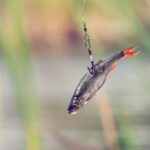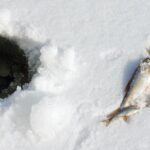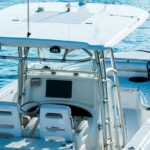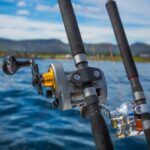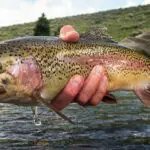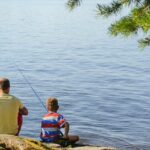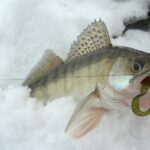Lake fishing is always exciting. There are several ways to fish a lake, many gear variations, and multiple techniques to try when fishing lakes. However, if you are new to lake fishing, it is important to understand what fishing rigs work well for this type of fishing. You will surely have a successful fishing day with the right lake fishing rig.
The best rigs to use in lakes are cast and retrieve rigs using spooners, in-line spinners, Texas bass worm lures, curl-tail grub lures, bottom fishing rigs using commercial or bottom-feeder bait, or float lures using live bait. All these rigs work very well in lakes.
The rig you use when fishing, regardless of the type of fishing, is critical. Without a rig well-suited for the type of fishing you are doing and the type of water you are fishing in, you are unlikely to catch many fish. Let’s explore the best rigs for lake fishing, regardless of your skill and experience level.

The Best Gear For Lake Fishing
Setting up the best rig for lake fishing begins with using the right gear for this type of fishing. There are multiple good options to choose from for every gear component in a fishing rig, and making the right decisions can determine your overall fishing experience.
Most anglers prefer using a medium-power rod for lake fishing combined with a good spinning reel. The reel does not need to be too high-speed, but a good fast reel is always helpful. The rod you choose should have good rigidity, but a fast and flexible rod tip can help with casting distance and accuracy.
Choose a medium-gauge line. 6 – 8 pound lines are great for lake fishing and usually have plenty of strength to handle most lake fish. These lines are versatile and can handle any techniques you may want to use on the lake.
Braided lines can be used to target larger fish, but they are usually more difficult to control and cast with. A monofilament line is usually best, especially if you are new to lake fishing.
A good fishing net is an optional but useful tool for lake fishing, especially when fishing from the shore.
You will also need tackle, bait, and lures. If you have access to a small boat such as a canoe, kayak, or Jon boat, these can be excellent tools for fishing on large lakes and will open up many more fishing opportunities.
You can be very successful when fishing from the shore on a lake, but if you have access to a boat, it is a good idea to use it, especially on large lakes.
Once you have the gear you need, it is time to think about the best baits and lures to use for your lake fishing rig.
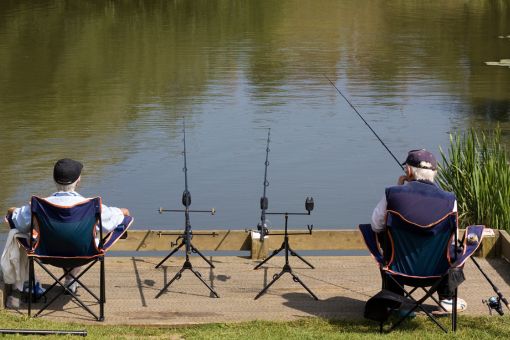
The Best Bait For Lake Fishing
Lake fishing is always interesting. Lakes typically support a large variety of fish species, which means that you can target the species that you catch by using bait, or you can use bait to catch a wide range of fish.
The best bait for lake fishing, regardless of the rig you use, is the bait that will work best for the fish you are trying to catch. The easiest bait to use is pre-made commercially prepared baits, such as Power Bait, as there is a solid range of baits available for specific fish and for catching any general fish.
If you are after a specific species, such as bass, trout, or catfish, it is best to tailor your bait accordingly. If you are looking for the easiest bait for lake fishing, use a general commercial fish bait or rig your line with bait that most carnivorous fish will take.
Some good lake fishing bait options include:
- Worms
- Chicken livers
- Leaches
- Minnows
- Crickets
- Grasshoppers
- Baitfish such as shiners
- Commercial fish bait
You can also use corn kernels, cooked maize bran, bread, and grubs if you choose, but the bait from the list above is usually the best option for lake fishing. Almost all freshwater fish will take these bait items, which have proven very effective.
If you need to get creative with bait options, you can use table scraps and certain vegetables such as broccoli or zucchini to catch fish, but these are only likely to catch smaller fish.
It is important to understand the fish in the lake you are fishing and design your bait options according to what works for those fish. This will significantly increase your chances of success on the day.
The Best Lures For Lake Fishing
Lake fishing rigs are often best used with lures. There are several types of lures you can use for lake fishing due to the wide range of fish present in lakes, and many excellent options complement lake fishing rigs very well.
The lures you use for lake fishing determine the fish species and the size you are likely to catch. However, there are fishing techniques that enable any lure to be used for any fish, so long as you use the right rig.
According to the best lake fishing anglers, there are four types of lures that work best for lake fishing, regardless of the fish you are targeting:
- Casting spoon lures
- Curl tail grub lures on jig heads
- Texas rig bass worm lures
- In-line spinners
These lures have been used for lake fishing for generations and are the best for almost all freshwater.
You can use hundreds of fishing techniques with these lures when lake fishing. They are the easiest lures to set up for very successful lake fishing rigs.
If you have a few of each of these in your tackle box, in different color variations, sizes, and styles, you have everything you need to catch some good fish on the lake.
Combine these lures with good fishing techniques, and you will likely catch plenty of freshwater fish, especially if you go fishing at the right time of day and in the right season for successful fishing.
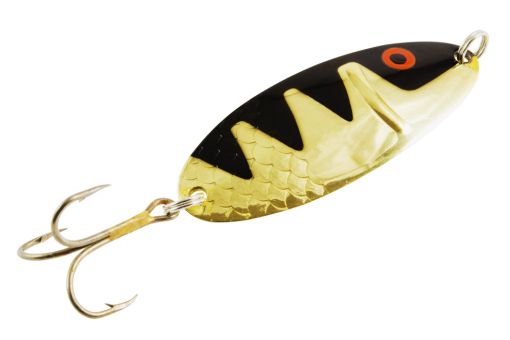
How To Set A Rig For Lake Fishing
Lake fishing is all about setting up your rig correctly. Fortunately, there are multiple ways to set up a fishing rig for lake fishing, all of which can be very successful, depending on the water and the fish you are targeting.
Lake fishing can be challenging, but if you set your rig correctly, you significantly increase the chances of catching fish.
There are three main ways to configure a lake fishing rig. You can set up your rig for bottom fishing as a cast and retrieve rig, or you can set your rig for a bobber or for float fishing.
All three rig setups are useful and can be successful, but they have varying difficulty levels and target different types of fish.
Let’s explore each of these rigs, how to set them up, and what they are useful for when lake catching. We will begin with cast and retrieve rigs, as these are usually the easiest to set up and use well.
Cast And Retrieve Rig
Cast and retrieve fishing is the most active form of lake fishing. It can be done from the shore or a boat and can be used to catch almost all fish species, depending on the tackle and techniques you use.
A simple cast and retrieve rig can be as basic as a spoon lure on the end of your line, with no other tackle. These rigs are the best for first-time or beginner anglers to use. Any lure can be used for this, and it helps the beginner practice critical fishing techniques.
In-line spinners are the best lures for the most active cast and retrieve styles, as they require movement to work well. These lures only spin when moving through the water, so they are exceptionally well suited for cast and retrieve fishing.
This method can catch your bass and any other predatory fish hunting for insects or small fish.
Set your cast and retrieve rig with a lure, or use some bait combined with a bait hook and a small weight for casting distance and line control.
Cast your line, and reel it in using various speeds, movements, and techniques to try and attract fish to bite. Take your time, move to various positions, try and fish areas where fish are likely to be, and you are sure to catch something eventually with a cast and retrieve rig.
These rigs are less likely to be as successful as other rigs, but they are the easiest to use, and the fact that you can cast and retrieve hundreds of times in a day means that the statistical chances of catching a fish are high in a well-populated lake.
Bottom Fishing Rig
A bottom fishing rig is highly successful in most lakes, especially when fishing for trout and other large fish that tend to feed at the bottom of lakes and other bodies of freshwater. This fishing rig can be very easy to set up, or it can be complex, depending on your skill level.
The easiest way to set up a bottom fishing rig for lake fishing is to use a one-ounce bell sinker, a bumper, a small barrel swivel, a pre-tied bait hook, and floating bait.
Simply slide the sinker onto your line, and attach a bumper in front of it. Tie the main to the barrel swivel, and tie the bait hook line to the other end of the swivel. Leave the sinker loose and sliding on the line.
Put your floating bait on the hook, and your rig is ready to go.
The reason why this bottom fishing rig is so successful is that the sinker pulls the line to the bottom, and the floating bait floats the hook line up a few inches from the bottom. The barrel swivel allows the bait to move freely and spin on the line.
Keeping the weight loose on the line keeps the line at the bottom. When a fish takes it, the weight does not move, and the swivel promotes natural movement, which means the fish is unlikely to notice the line until the hook is set.
This makes it far easier to catch very large bottom feeders, especially trout. This bottom fishing rig is the simplest rig to set up that still has a high chance of success, especially if you use a good bait such as power Bait rainbow marshmallows, which are known to work well for most game fish.
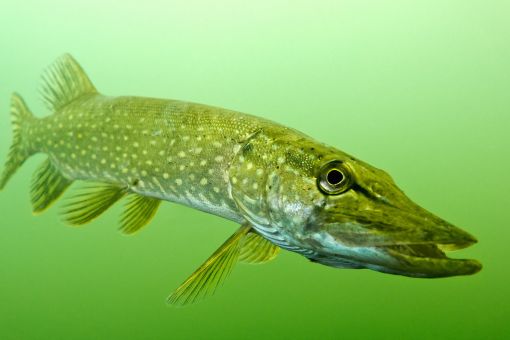
Bobber Rig
Bobber rigs are often the most difficult to use for lake fishing and usually require the most time and effort to use well.
If you want to set up a simple bobber or float rig, attach a baited hook to a line with a small sinker a few inches up from it and attach a clip-on bobber or float to the line about a foot from the hook.
Cast the line out, and the weight will sink down, while the bait floats a little higher than the weight, close to the surface, and the bobber provides extra buoyancy to the line and provides a visual cue for when a fish has taken the bait.
This rig is very useful for fishing for carp and other such fish, but it is likely to work for any fish that feeds near the surface of the water.
The main draw to bobber or floater rigs is that they are very easy to use from the shore, and they can be set and left alone until a fish takes the hook.
This makes float fishing very relaxing and is a great way to learn skills such as patience and when to set a hook on a biting fish.
Why Does Lake Fishing Require Specific Rigs?
Lake fishing is exciting, and there are many variables to consider, but is it necessary to have specific rigs for lake fishing?
The rigs required for lake fishing are not due to the environment but rather for the fish that you are likely to catch in a lake.
Lakes host a very wide range of fish of all sizes. This means that you must choose a rig that is designed to catch as wide a range of fish as possible, such as cast and retrieve rigs, or you must use a rig designed to catch one type of fish, such as a bottom fishing rig.
It is very difficult to fish a lake successfully without knowing how to set a rig correctly for versatility or target fish.
Specific rigs are necessary for fishing lakes to maximize effectiveness and success while fishing these waters.
Without rigs designed for lake fishing and the fish that are present in lakes, it is very unlikely that the rig will be successful.
Every lake fishing rig must be adjusted and tweaked to account for specific fish species in specific lakes, the temperature and weather, and the environment of the lake itself. If you take the time to set your rig for fishing in a lake, you are far more likely to catch fish, especially when targeting particular species.
Can You Use A Basic Rig For Lake Fishing?
We have established that certain rigs are designed for lake fishing, but many new anglers wonder if you can use any basic rig for lake fishing or if you have to spend the time and effort developing a lake fishing rig.
You can use any rig you have for fishing anywhere. The advantage of a lake fishing rig is that it is more likely to hook fish, but there are many stories of people catching several fish with the most basic gear not designed for any particular type of fishing.
If you do not have the time, money, or ability to set up a dedicated lake fishing rig, use what you have and learn about the lake you are fishing in to maximize your chance of success.
Learn what types of fish are likely to be in the lake and base your strategies on those fish. For example, bass are more likely to bite in the early morning the late afternoon. Trout are more likely to bite in summer or spring after they spawn.
Learning about the area and the fish gives you a better chance of catching fish, regardless of your rig.
If you have only a basic rig, use the power of knowledge to your advantage, and go fishing when the conditions are optimal, and you are still likely to catch something, even if your rig is not well suited for lake fishing.
Conclusion
Rigging for lake fishing is the key to successful lake fishing. Without a good rig, it is far more difficult to catch anything. Using a rig designed for lake fishing drastically increases the enjoyment and success of the day, providing a far better lake fishing experience.
If you are new to lake fishing, or if you want to try it for the first time, try various fishing rigs based on your style and the fish you want to catch, and you are sure to catch some great fish!
- Do You Need An Indicator For Nymph Fishing? - November 16, 2023
- Fishing Safety Tips For Families - September 25, 2023
- What Is The Best Time To Night Fish At A Lake? - September 18, 2023


